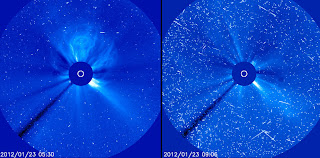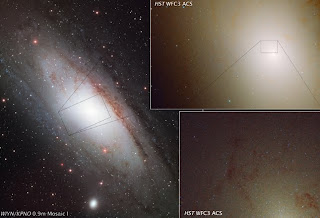
Leaner, greener flying machines for the year 2025 are on the drawing boards of three industry teams under contract to the NASA Aeronautics Research Mission Directorate's Environmentally Responsible Aviation Project.
Teams from The Boeing Company in Huntington Beach, Calif., Lockheed Martin in Palmdale, Calif., and Northrop Grumman in El Segundo, Calif., have spent the last year studying how to meet NASA goals to develop technology that would allow future aircraft to burn 50 percent less fuel than aircraft that entered service in 1998 (the baseline for the study), with 75 percent fewer harmful emissions; and to shrink the size of geographic areas affected by objectionable airport noise by 83 percent.
"The real challenge is we want to accomplish all these things simultaneously," said ERA project manager Fay Collier. "It's never been done before. We looked at some very difficult metrics and tried to push all those metrics down at the same time."
So NASA put that challenge to industry awarding a little less than $11 million to the three teams to assess what kinds of aircraft designs and technologies could help meet the goals. The companies have just given NASA their results.
"We'll be digesting the three studies and we'll be looking into what to do next," said Collier.
Boeing's advanced vehicle concept centers around the company's now familiar blended wing body design as seen in the sub-scale remotely piloted X-48, which has been wind tunnel tested at NASA's Langley Research Center and flown at NASA's Dryden Flight Research Center. One thing that makes this concept different from current airplanes is the placement of its Pratt & Whitney geared turbofan engines.
The engines are on top of the plane's back end, flanked by two vertical tails to shield people on the ground from engine noise. The aircraft also would feature an advanced lightweight, damage tolerant, composite structure; technologies for reducing airframe noise; advanced flight controls; hybrid laminar flow control, which means surfaces designed to reduce drag; and long-span wings which improve fuel efficiency.
Also visit : graphic design dubai
Teams from The Boeing Company in Huntington Beach, Calif., Lockheed Martin in Palmdale, Calif., and Northrop Grumman in El Segundo, Calif., have spent the last year studying how to meet NASA goals to develop technology that would allow future aircraft to burn 50 percent less fuel than aircraft that entered service in 1998 (the baseline for the study), with 75 percent fewer harmful emissions; and to shrink the size of geographic areas affected by objectionable airport noise by 83 percent.
"The real challenge is we want to accomplish all these things simultaneously," said ERA project manager Fay Collier. "It's never been done before. We looked at some very difficult metrics and tried to push all those metrics down at the same time."
So NASA put that challenge to industry awarding a little less than $11 million to the three teams to assess what kinds of aircraft designs and technologies could help meet the goals. The companies have just given NASA their results.
"We'll be digesting the three studies and we'll be looking into what to do next," said Collier.
Boeing's advanced vehicle concept centers around the company's now familiar blended wing body design as seen in the sub-scale remotely piloted X-48, which has been wind tunnel tested at NASA's Langley Research Center and flown at NASA's Dryden Flight Research Center. One thing that makes this concept different from current airplanes is the placement of its Pratt & Whitney geared turbofan engines.
The engines are on top of the plane's back end, flanked by two vertical tails to shield people on the ground from engine noise. The aircraft also would feature an advanced lightweight, damage tolerant, composite structure; technologies for reducing airframe noise; advanced flight controls; hybrid laminar flow control, which means surfaces designed to reduce drag; and long-span wings which improve fuel efficiency.
Also visit : graphic design dubai



















